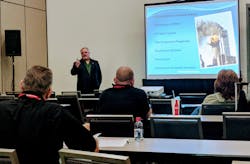FHWorld18: Invisible Wounds of the First Responder
First responders see people on their worst days. Even one difficult call can start a chain reaction of psychological pain. Similarly, repeated exposure to traumatic incidents can take a significant toll on mental and physical health over time. And if responders don’t get the help they need following such calls, they can develop symptoms of or full post-traumatic stress disorder (PTSD). Unfortunately, many responders simply don’t know where—or how—to ask for help. Part of this problem is rooted in the public safety tradition of “toughness.”
“We’re firefighters—we’re supposed to be the biggest and baddest out there; we’re not supposed to hurt,” said Captain (ret.) Rick Smith.
In his Firehouse World session “Invisible Wounds of the First Responder,” Smith detailed PTSD causes, symptoms, prevention and treatment, and explained his own experience with the disorder. Fortunately, Smith sought help and now shares his story with other first responders to offer insight into an often-ignored topic in public safety.
What is PTSD?
PTSD is a potentially debilitating anxiety/psychological disorder triggered by exposure to a traumatic experience, such as an interpersonal event like physical or sexual assault, exposure to disaster or accidents, combat or witnessing a traumatic event.
PTSD is believed to be caused by experiencing any of a wide range of events that produce intense negative feelings of fear, helplessness or horror. Such events are common for first responders who can see traumatic events in the course of their jobs, sometimes on a regular basis. In fact, Smith noted that a study published in The Journal of Traumatic Stress in 2017 shows that approximately 1 in 10 firefighters interviewed showed symptoms of PTSD. He added that other studies suggest the numbers are closer to 1 in 3 or 1 in 5.
PTSD symptoms
PTSD affects how the body reacts to stress, changing stress hormones and chemicals that are transmitted between the nerves. There are no lab tests or brain scans that can be performed to ascertain if someone is suffering from PTSD. It must be diagnosed by a physician or clinician.
Some of the symptoms a physician will look for when making a diagnosis include the following:
- Exposure to a traumatic event: The event involved both a loss of physical integrity or risk of serious injury or death to self or others, as well as a response to the event that involved intense fear, horror or helplessness.
- Persistent re-experiencing: The person experiences flashback memories, recurring distressing dreams, subjective re-experiencing of the traumatic event(s), or intense negative psychological or physiological response to any objective or subjective reminder of the traumatic events.
- Persistent avoidance and emotional numbing. For example, avoidance of stimuli associated with the trauma, such as certain thoughts or feelings or talking about the event; avoidance of behaviors, places or people that might lead to a distressing memory as well as the disturbing memories, dreams, flashbacks and intense psychological or physiological distress; inability to recall major parts of the trauma or decreased involvement in significant life activities; decreased capacity (to complete inability) to feel certain feelings; an expectation that one’s future will be somehow constrained in ways not normal to other people.
A person with acute or chronic PTSD will experience symptoms that last for 1–3 months (acute) or for months or even years (chronic). A person who has delayed PTSD may not show any symptoms until a considerable period of time has elapsed after the initial stressor has occurred. It may be years before symptoms develop.
Smith then offered a brief assessment quiz that first responders can use by answering Yes or No to experiencing the following symptoms:
- A significant change in appetite
- Recurring disturbances in sleep pattern
- Increased agitation or inability to relax
- Fatigue, lethargy or loss of energy
- Sadness, despondency, despair or loneliness
- Inability to concentrate, focus or make decisions
- Recurring thoughts of death or suicide
- Plans for suicide or an attempt at suicide
He underscored that answering “yes” to any of these questions does not necessarily mean you have PTSD, but they are red flags that something may be going on—and encourages seeking assistance.
A more comprehensive list of symptoms breaks them into several categories—intrusion, avoidance, arousal and somatic:
Intrusion
- Extreme nightmares
- Extreme paranoia
- Sense of shortened future, impending doom
Avoidance
- Loss of interest in sex
- Depression, isolation, especially from loved ones
- Avoiding work; increased absenteeism
- Avoiding certain previously visited locations that were favorites
- Diminished interested in previously interesting activities
- Lack of motivation
- Constantly fatigued
- Loss of faith
Arousal
- Problems with falling asleep or staying asleep
- Irritability
- Worse-than-usual problems with management and/or the public
- More-than-usual contempt/exasperation with supervision, public
- Increasingly cynical, maybe at most everything
- Sudden outbursts of anger or rage
- Hypervigilance (paranoia) exaggerated with startle response
- Obsessive behavior
- Compulsive behavior
Somatic problems
- Problems urinating
- Frequent headaches
- Chest pain
- Diarrhea, constipation, IBS, blood in stool
- High use of antacids
Somatic symptoms are digressive, meaning that if they are not treated, they will probably get worse over time, Smith said.
“PTSD does not go away by itself,” Smith stressed.
Smith also noted that PTSD symptoms in first responders can impair decision-making abilities and functioning, which could pose significant risk to the general population that relies on them to quickly and effectively coordinate an emergency response. It is therefore imperative that anyone experiencing symptoms of PTSD seek assistance to ensure their own safety and that of the public.
Treatment for PTSD
The key, Smith said, is that “treatment can only start with you, standing up and saying that you need help.”
Several medications have shown adjunctive benefits in reducing PTSD symptoms; however, there is no clear drug treatment for PTSD. Medications, such as anti-depressants, have been used to help minimize anxiety and manage depressed mood. Sleep aids may also be used for those who have trouble sleeping and are bothered by nightmares.
There are also treatment centers where first responders can seek help, including the West Coast Post-Traumatic Retreat and the IAFF Center for Excellence, which is specifically designed for public safety personnel. Smith also mentioned the iPhone app PTSD Coach, which provides education about PTSD, information about professional care, a self-assessment for PTSD, opportunities to find support, and tools that can help manage the stresses of daily life with PTSD.
Smith also talked about behavior-based treatment, specifically, Cognitive Behavioral Therapy (CBT), which has been proven to be an effective treatment for PTSD. CBT seeks to change the way a trauma victim feels and acts by changing the patterns of thinking or behavior, or both, responsible for the negative emotions. In CBT, individuals learn to identify thoughts that make them feel afraid or upset and replace them with less distressing thoughts.
Finding peace
Smith explained that one of the things he learned through his experience with PTSD is that it’s important to find a place of serenity—where you can go to feel safe and at peace with yourself. This is especially important for first responders who have long been told to “toughen up” and “take the heat.” People call first responders because they “fix everything,” Smith said, adding that we now need to ask, “Who is going to be there when we need fixing?”
About the Author

Janelle Foskett
Janelle Foskett served as editorial director of Firehouse Magazine and Firehouse.com, overseeing the editorial operations for the print edition along with working closely with the Web team.
